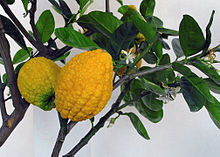
Back ትርንጎ Amharic أترج Arabic اترج ARZ Citrus medica AST Sedratez Breton Poncem Catalan Citrus medica CEB Limea Corsican Cedrát Czech Цитрон CV
| Citron | |
|---|---|

| |
| Scientific classification | |
| Kingdom: | Plantae |
| Clade: | Tracheophytes |
| Clade: | Angiosperms |
| Clade: | Eudicots |
| Clade: | Rosids |
| Order: | Sapindales |
| Family: | Rutaceae |
| Genus: | Citrus |
| Species: | C. medica
|
| Binomial name | |
| Citrus medica | |
| Synonyms[2][3] | |
The citron (Citrus medica), historically cedrate,[4] is a large fragrant citrus fruit with a thick rind. It is said to resemble a 'huge, rough lemon'.[5] It is one of the original citrus fruits from which all other citrus types developed through natural hybrid speciation or artificial hybridization.[6] Though citron cultivars take on a wide variety of physical forms, they are all closely related genetically. It is used in Asian and Mediterranean cuisine, traditional medicines, perfume, and religious rituals and offerings. Hybrids of citrons with other citrus are commercially more prominent, notably lemons and many limes.
- ^ Plummer, J. 2021. Citrus medica. The IUCN Red List of Threatened Species 2021: e.T62041221A62041228. Downloaded on 06 September 2021.
- ^ Ollitrault, Patrick; Curk, Franck; Krueger, Robert (2020). "Citrus taxonomy". In Talon, Manuel; Caruso, Marco; Gmitter, Fred G Jr. (eds.). The Citrus Genus. Elsevier. pp. 57–81. doi:10.1016/B978-0-12-812163-4.00004-8. ISBN 9780128121634. S2CID 242819146.
- ^ "Citrus medica L. Sp. Pl. : 782 (1753)". World Flora Online. World Flora Consortium. 2022. Retrieved 11 December 2022.
- ^ "Cedrate". Collins English Dictionary.
- ^ Davidson, Alan (2014). Tom Jaine (ed.). The Oxford Companion to Food. Illustrated by Soun Vannithone (3rd ed.). Oxford University Press. p. 191. ISBN 978-0-19-967733-7. OCLC 890807357.
- ^ Klein, J. (2014). "Citron Cultivation, Production and Uses in the Mediterranean Region". In Z. Yaniv; N. Dudai (eds.). Medicinal and Aromatic Plants of the Middle-East. Medicinal and Aromatic Plants of the World. Vol. 2. Springer Netherlands. pp. 199–214. doi:10.1007/978-94-017-9276-9_10. ISBN 978-94-017-9275-2.
